Health Assessment for the Clinician: A Detailed Report
VerifiedAdded on 2021/04/24
|5
|1584
|65
Report
AI Summary
This report, prepared for the NURS4010 course, provides a comprehensive overview of health assessment for clinicians. It begins by defining health assessment and its significance in identifying patient needs and detecting diseases early. The report then delves into the importance of health history and physical examinations, highlighting how they contribute to accurate diagnosis and effective treatment plans. It explores various health assessment frameworks and models, including Gordon's framework, Orem's self-care framework, and the logic model, comparing their strengths and weaknesses. The report emphasizes the advantages of Gordon's framework in gathering comprehensive patient data and its widespread use in healthcare institutions. It also discusses the ethical and professional considerations involved in health assessments, such as patient consent and comfort. In conclusion, the report underscores the value of health assessment in collecting valid data, predicting health risks, coordinating care, and evaluating patient progress, ultimately contributing to patient-centered care.
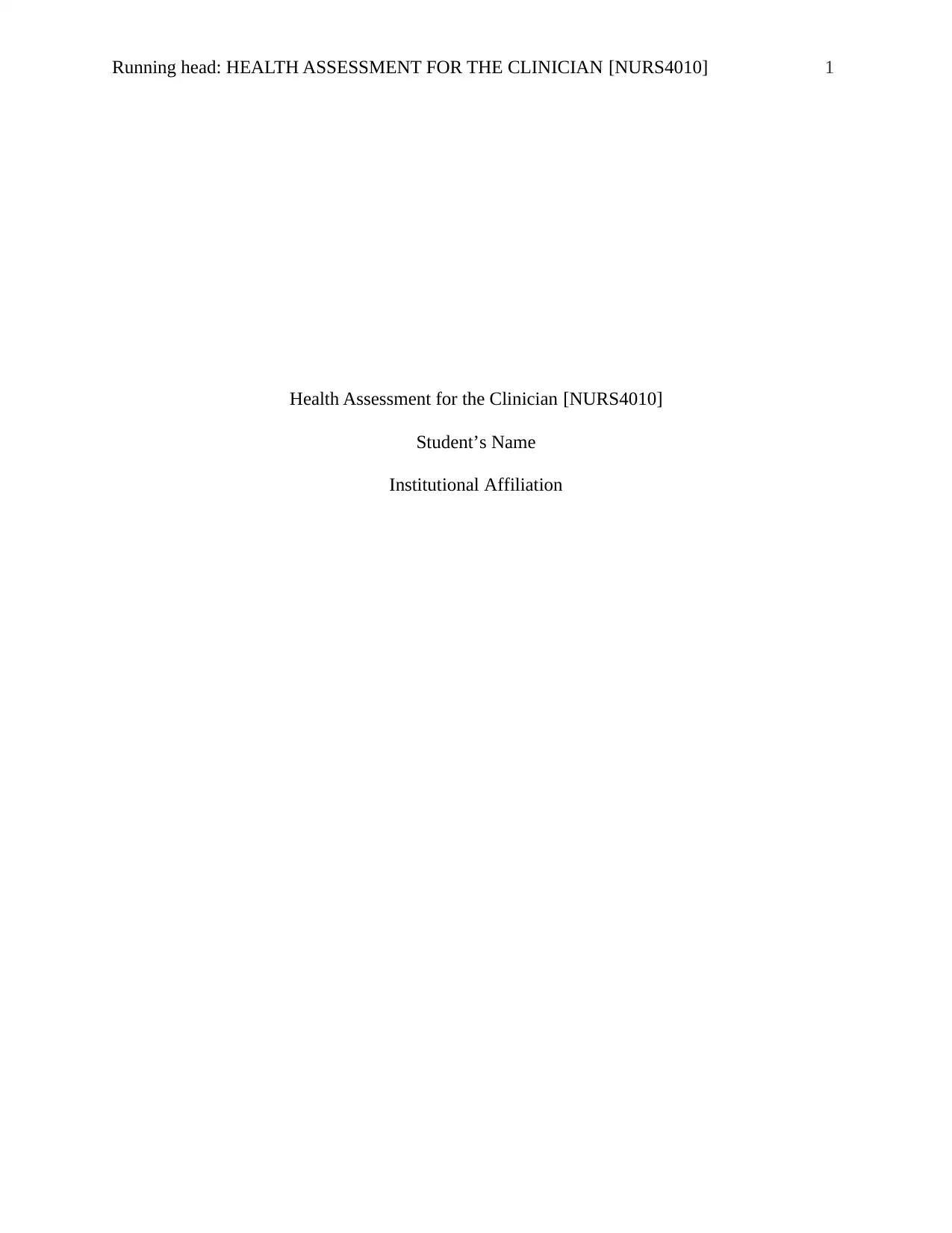
Running head: HEALTH ASSESSMENT FOR THE CLINICIAN [NURS4010] 1
Health Assessment for the Clinician [NURS4010]
Student’s Name
Institutional Affiliation
Health Assessment for the Clinician [NURS4010]
Student’s Name
Institutional Affiliation
Paraphrase This Document
Need a fresh take? Get an instant paraphrase of this document with our AI Paraphraser
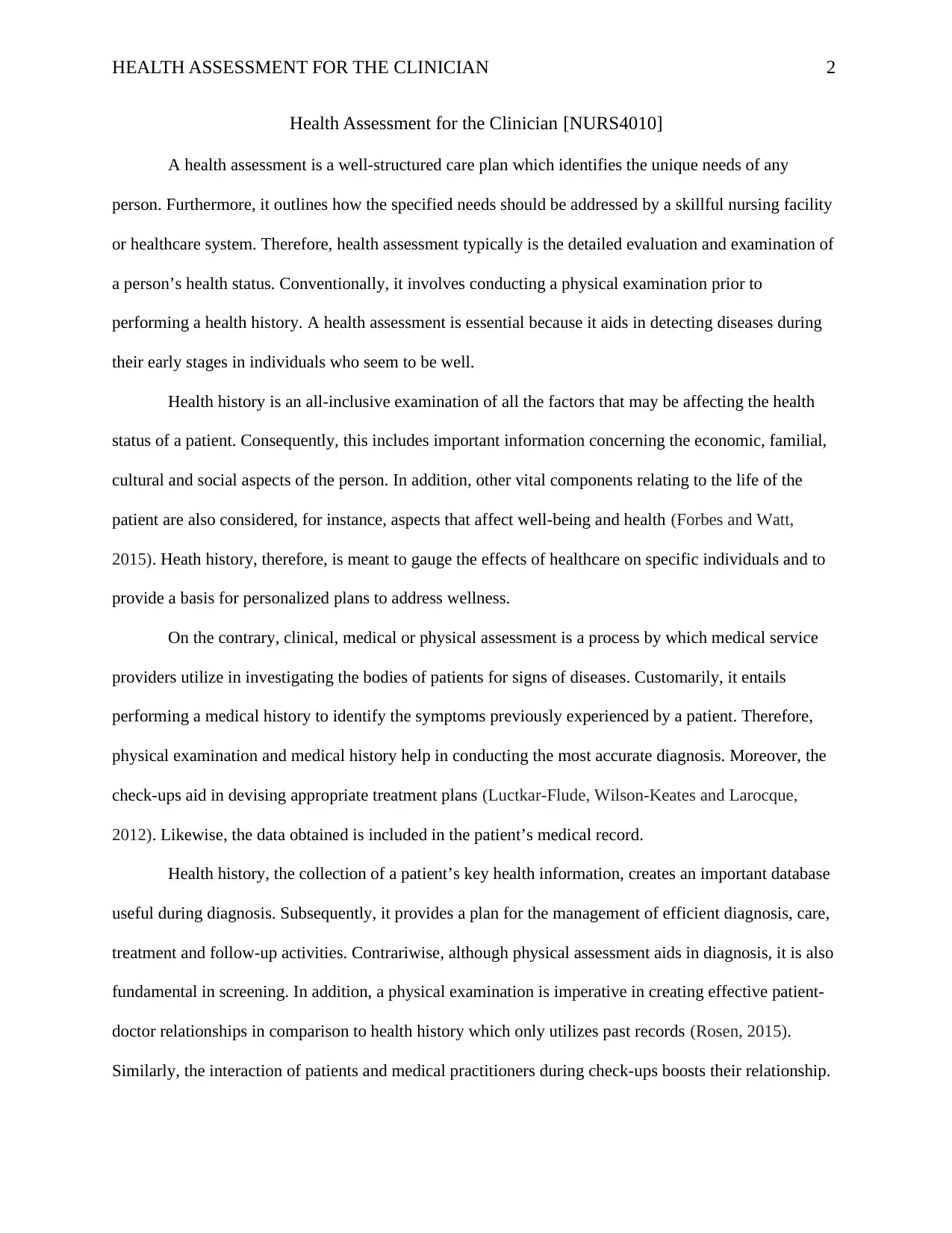
HEALTH ASSESSMENT FOR THE CLINICIAN 2
Health Assessment for the Clinician [NURS4010]
A health assessment is a well-structured care plan which identifies the unique needs of any
person. Furthermore, it outlines how the specified needs should be addressed by a skillful nursing facility
or healthcare system. Therefore, health assessment typically is the detailed evaluation and examination of
a person’s health status. Conventionally, it involves conducting a physical examination prior to
performing a health history. A health assessment is essential because it aids in detecting diseases during
their early stages in individuals who seem to be well.
Health history is an all-inclusive examination of all the factors that may be affecting the health
status of a patient. Consequently, this includes important information concerning the economic, familial,
cultural and social aspects of the person. In addition, other vital components relating to the life of the
patient are also considered, for instance, aspects that affect well-being and health (Forbes and Watt,
2015). Heath history, therefore, is meant to gauge the effects of healthcare on specific individuals and to
provide a basis for personalized plans to address wellness.
On the contrary, clinical, medical or physical assessment is a process by which medical service
providers utilize in investigating the bodies of patients for signs of diseases. Customarily, it entails
performing a medical history to identify the symptoms previously experienced by a patient. Therefore,
physical examination and medical history help in conducting the most accurate diagnosis. Moreover, the
check-ups aid in devising appropriate treatment plans (Luctkar-Flude, Wilson-Keates and Larocque,
2012). Likewise, the data obtained is included in the patient’s medical record.
Health history, the collection of a patient’s key health information, creates an important database
useful during diagnosis. Subsequently, it provides a plan for the management of efficient diagnosis, care,
treatment and follow-up activities. Contrariwise, although physical assessment aids in diagnosis, it is also
fundamental in screening. In addition, a physical examination is imperative in creating effective patient-
doctor relationships in comparison to health history which only utilizes past records (Rosen, 2015).
Similarly, the interaction of patients and medical practitioners during check-ups boosts their relationship.
Health Assessment for the Clinician [NURS4010]
A health assessment is a well-structured care plan which identifies the unique needs of any
person. Furthermore, it outlines how the specified needs should be addressed by a skillful nursing facility
or healthcare system. Therefore, health assessment typically is the detailed evaluation and examination of
a person’s health status. Conventionally, it involves conducting a physical examination prior to
performing a health history. A health assessment is essential because it aids in detecting diseases during
their early stages in individuals who seem to be well.
Health history is an all-inclusive examination of all the factors that may be affecting the health
status of a patient. Consequently, this includes important information concerning the economic, familial,
cultural and social aspects of the person. In addition, other vital components relating to the life of the
patient are also considered, for instance, aspects that affect well-being and health (Forbes and Watt,
2015). Heath history, therefore, is meant to gauge the effects of healthcare on specific individuals and to
provide a basis for personalized plans to address wellness.
On the contrary, clinical, medical or physical assessment is a process by which medical service
providers utilize in investigating the bodies of patients for signs of diseases. Customarily, it entails
performing a medical history to identify the symptoms previously experienced by a patient. Therefore,
physical examination and medical history help in conducting the most accurate diagnosis. Moreover, the
check-ups aid in devising appropriate treatment plans (Luctkar-Flude, Wilson-Keates and Larocque,
2012). Likewise, the data obtained is included in the patient’s medical record.
Health history, the collection of a patient’s key health information, creates an important database
useful during diagnosis. Subsequently, it provides a plan for the management of efficient diagnosis, care,
treatment and follow-up activities. Contrariwise, although physical assessment aids in diagnosis, it is also
fundamental in screening. In addition, a physical examination is imperative in creating effective patient-
doctor relationships in comparison to health history which only utilizes past records (Rosen, 2015).
Similarly, the interaction of patients and medical practitioners during check-ups boosts their relationship.
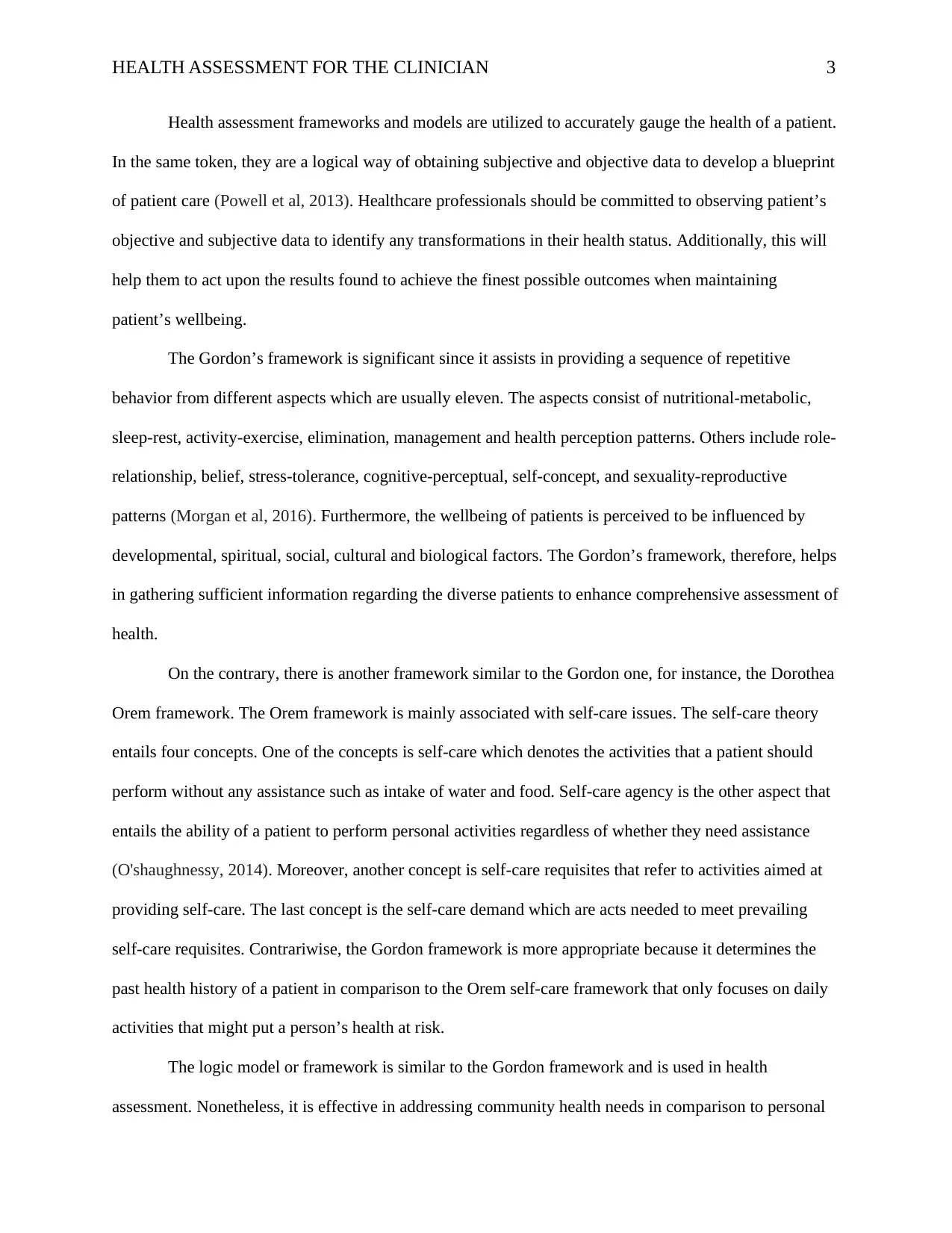
HEALTH ASSESSMENT FOR THE CLINICIAN 3
Health assessment frameworks and models are utilized to accurately gauge the health of a patient.
In the same token, they are a logical way of obtaining subjective and objective data to develop a blueprint
of patient care (Powell et al, 2013). Healthcare professionals should be committed to observing patient’s
objective and subjective data to identify any transformations in their health status. Additionally, this will
help them to act upon the results found to achieve the finest possible outcomes when maintaining
patient’s wellbeing.
The Gordon’s framework is significant since it assists in providing a sequence of repetitive
behavior from different aspects which are usually eleven. The aspects consist of nutritional-metabolic,
sleep-rest, activity-exercise, elimination, management and health perception patterns. Others include role-
relationship, belief, stress-tolerance, cognitive-perceptual, self-concept, and sexuality-reproductive
patterns (Morgan et al, 2016). Furthermore, the wellbeing of patients is perceived to be influenced by
developmental, spiritual, social, cultural and biological factors. The Gordon’s framework, therefore, helps
in gathering sufficient information regarding the diverse patients to enhance comprehensive assessment of
health.
On the contrary, there is another framework similar to the Gordon one, for instance, the Dorothea
Orem framework. The Orem framework is mainly associated with self-care issues. The self-care theory
entails four concepts. One of the concepts is self-care which denotes the activities that a patient should
perform without any assistance such as intake of water and food. Self-care agency is the other aspect that
entails the ability of a patient to perform personal activities regardless of whether they need assistance
(O'shaughnessy, 2014). Moreover, another concept is self-care requisites that refer to activities aimed at
providing self-care. The last concept is the self-care demand which are acts needed to meet prevailing
self-care requisites. Contrariwise, the Gordon framework is more appropriate because it determines the
past health history of a patient in comparison to the Orem self-care framework that only focuses on daily
activities that might put a person’s health at risk.
The logic model or framework is similar to the Gordon framework and is used in health
assessment. Nonetheless, it is effective in addressing community health needs in comparison to personal
Health assessment frameworks and models are utilized to accurately gauge the health of a patient.
In the same token, they are a logical way of obtaining subjective and objective data to develop a blueprint
of patient care (Powell et al, 2013). Healthcare professionals should be committed to observing patient’s
objective and subjective data to identify any transformations in their health status. Additionally, this will
help them to act upon the results found to achieve the finest possible outcomes when maintaining
patient’s wellbeing.
The Gordon’s framework is significant since it assists in providing a sequence of repetitive
behavior from different aspects which are usually eleven. The aspects consist of nutritional-metabolic,
sleep-rest, activity-exercise, elimination, management and health perception patterns. Others include role-
relationship, belief, stress-tolerance, cognitive-perceptual, self-concept, and sexuality-reproductive
patterns (Morgan et al, 2016). Furthermore, the wellbeing of patients is perceived to be influenced by
developmental, spiritual, social, cultural and biological factors. The Gordon’s framework, therefore, helps
in gathering sufficient information regarding the diverse patients to enhance comprehensive assessment of
health.
On the contrary, there is another framework similar to the Gordon one, for instance, the Dorothea
Orem framework. The Orem framework is mainly associated with self-care issues. The self-care theory
entails four concepts. One of the concepts is self-care which denotes the activities that a patient should
perform without any assistance such as intake of water and food. Self-care agency is the other aspect that
entails the ability of a patient to perform personal activities regardless of whether they need assistance
(O'shaughnessy, 2014). Moreover, another concept is self-care requisites that refer to activities aimed at
providing self-care. The last concept is the self-care demand which are acts needed to meet prevailing
self-care requisites. Contrariwise, the Gordon framework is more appropriate because it determines the
past health history of a patient in comparison to the Orem self-care framework that only focuses on daily
activities that might put a person’s health at risk.
The logic model or framework is similar to the Gordon framework and is used in health
assessment. Nonetheless, it is effective in addressing community health needs in comparison to personal
⊘ This is a preview!⊘
Do you want full access?
Subscribe today to unlock all pages.

Trusted by 1+ million students worldwide
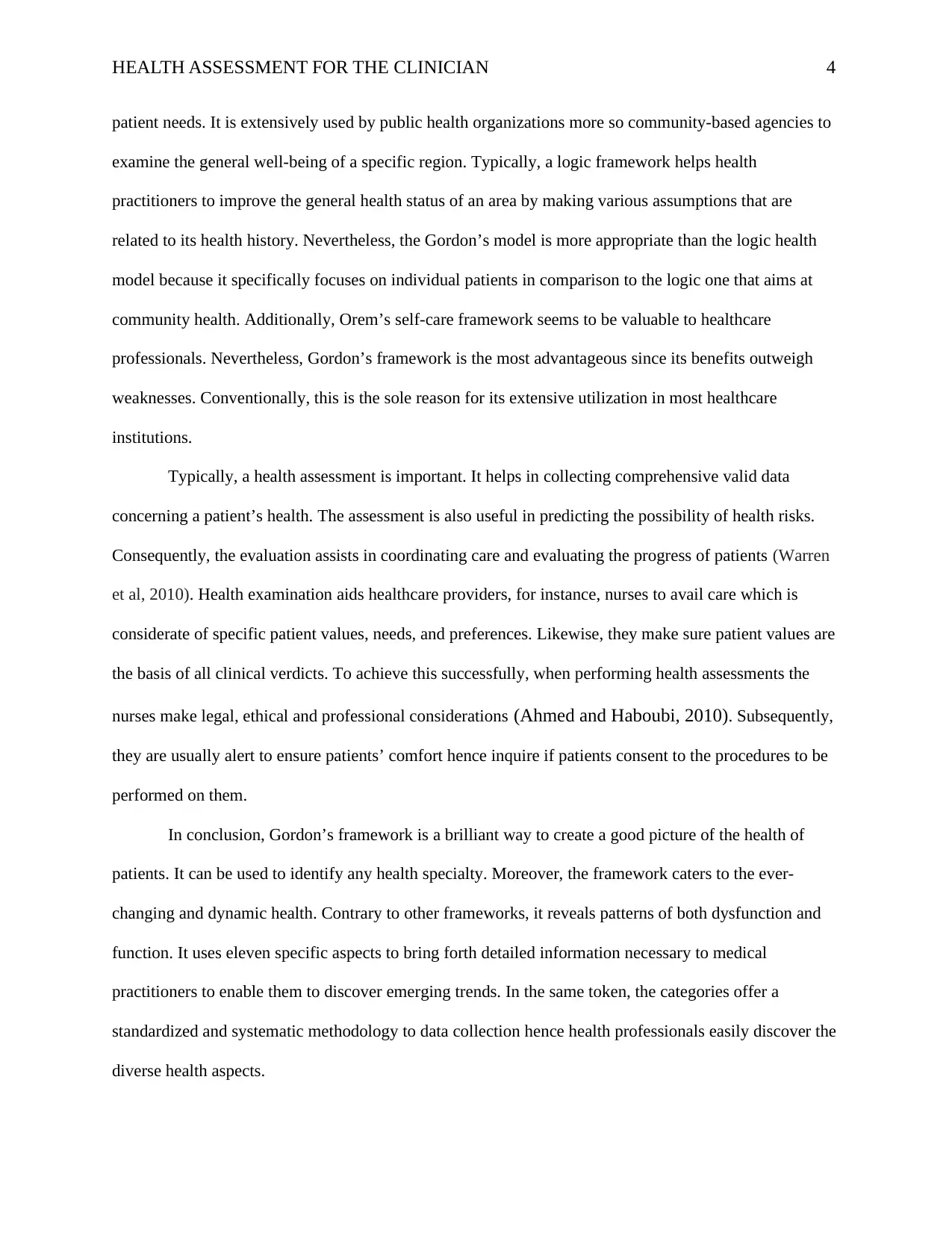
HEALTH ASSESSMENT FOR THE CLINICIAN 4
patient needs. It is extensively used by public health organizations more so community-based agencies to
examine the general well-being of a specific region. Typically, a logic framework helps health
practitioners to improve the general health status of an area by making various assumptions that are
related to its health history. Nevertheless, the Gordon’s model is more appropriate than the logic health
model because it specifically focuses on individual patients in comparison to the logic one that aims at
community health. Additionally, Orem’s self-care framework seems to be valuable to healthcare
professionals. Nevertheless, Gordon’s framework is the most advantageous since its benefits outweigh
weaknesses. Conventionally, this is the sole reason for its extensive utilization in most healthcare
institutions.
Typically, a health assessment is important. It helps in collecting comprehensive valid data
concerning a patient’s health. The assessment is also useful in predicting the possibility of health risks.
Consequently, the evaluation assists in coordinating care and evaluating the progress of patients (Warren
et al, 2010). Health examination aids healthcare providers, for instance, nurses to avail care which is
considerate of specific patient values, needs, and preferences. Likewise, they make sure patient values are
the basis of all clinical verdicts. To achieve this successfully, when performing health assessments the
nurses make legal, ethical and professional considerations (Ahmed and Haboubi, 2010). Subsequently,
they are usually alert to ensure patients’ comfort hence inquire if patients consent to the procedures to be
performed on them.
In conclusion, Gordon’s framework is a brilliant way to create a good picture of the health of
patients. It can be used to identify any health specialty. Moreover, the framework caters to the ever-
changing and dynamic health. Contrary to other frameworks, it reveals patterns of both dysfunction and
function. It uses eleven specific aspects to bring forth detailed information necessary to medical
practitioners to enable them to discover emerging trends. In the same token, the categories offer a
standardized and systematic methodology to data collection hence health professionals easily discover the
diverse health aspects.
patient needs. It is extensively used by public health organizations more so community-based agencies to
examine the general well-being of a specific region. Typically, a logic framework helps health
practitioners to improve the general health status of an area by making various assumptions that are
related to its health history. Nevertheless, the Gordon’s model is more appropriate than the logic health
model because it specifically focuses on individual patients in comparison to the logic one that aims at
community health. Additionally, Orem’s self-care framework seems to be valuable to healthcare
professionals. Nevertheless, Gordon’s framework is the most advantageous since its benefits outweigh
weaknesses. Conventionally, this is the sole reason for its extensive utilization in most healthcare
institutions.
Typically, a health assessment is important. It helps in collecting comprehensive valid data
concerning a patient’s health. The assessment is also useful in predicting the possibility of health risks.
Consequently, the evaluation assists in coordinating care and evaluating the progress of patients (Warren
et al, 2010). Health examination aids healthcare providers, for instance, nurses to avail care which is
considerate of specific patient values, needs, and preferences. Likewise, they make sure patient values are
the basis of all clinical verdicts. To achieve this successfully, when performing health assessments the
nurses make legal, ethical and professional considerations (Ahmed and Haboubi, 2010). Subsequently,
they are usually alert to ensure patients’ comfort hence inquire if patients consent to the procedures to be
performed on them.
In conclusion, Gordon’s framework is a brilliant way to create a good picture of the health of
patients. It can be used to identify any health specialty. Moreover, the framework caters to the ever-
changing and dynamic health. Contrary to other frameworks, it reveals patterns of both dysfunction and
function. It uses eleven specific aspects to bring forth detailed information necessary to medical
practitioners to enable them to discover emerging trends. In the same token, the categories offer a
standardized and systematic methodology to data collection hence health professionals easily discover the
diverse health aspects.
Paraphrase This Document
Need a fresh take? Get an instant paraphrase of this document with our AI Paraphraser
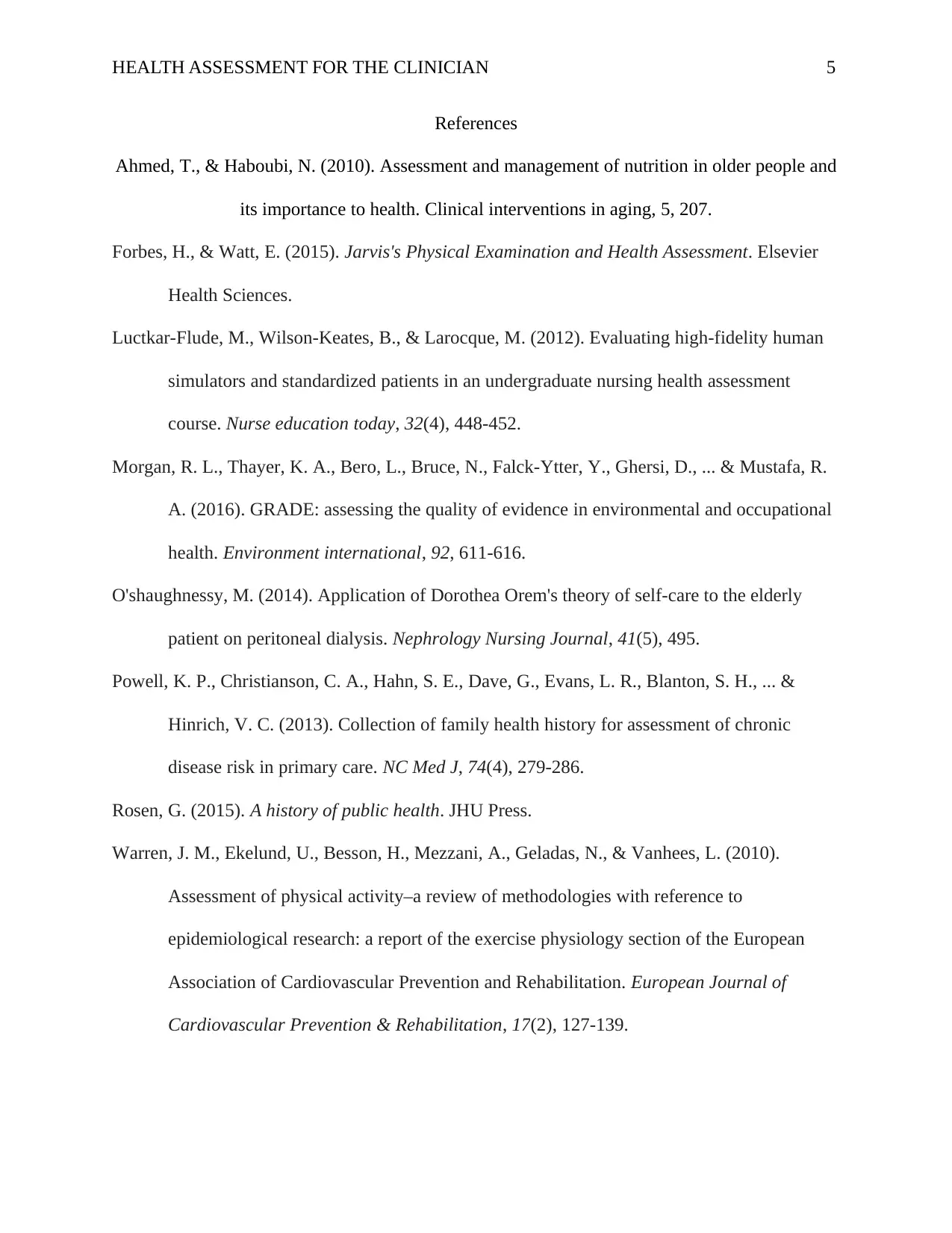
HEALTH ASSESSMENT FOR THE CLINICIAN 5
References
Ahmed, T., & Haboubi, N. (2010). Assessment and management of nutrition in older people and
its importance to health. Clinical interventions in aging, 5, 207.
Forbes, H., & Watt, E. (2015). Jarvis's Physical Examination and Health Assessment. Elsevier
Health Sciences.
Luctkar-Flude, M., Wilson-Keates, B., & Larocque, M. (2012). Evaluating high-fidelity human
simulators and standardized patients in an undergraduate nursing health assessment
course. Nurse education today, 32(4), 448-452.
Morgan, R. L., Thayer, K. A., Bero, L., Bruce, N., Falck-Ytter, Y., Ghersi, D., ... & Mustafa, R.
A. (2016). GRADE: assessing the quality of evidence in environmental and occupational
health. Environment international, 92, 611-616.
O'shaughnessy, M. (2014). Application of Dorothea Orem's theory of self-care to the elderly
patient on peritoneal dialysis. Nephrology Nursing Journal, 41(5), 495.
Powell, K. P., Christianson, C. A., Hahn, S. E., Dave, G., Evans, L. R., Blanton, S. H., ... &
Hinrich, V. C. (2013). Collection of family health history for assessment of chronic
disease risk in primary care. NC Med J, 74(4), 279-286.
Rosen, G. (2015). A history of public health. JHU Press.
Warren, J. M., Ekelund, U., Besson, H., Mezzani, A., Geladas, N., & Vanhees, L. (2010).
Assessment of physical activity–a review of methodologies with reference to
epidemiological research: a report of the exercise physiology section of the European
Association of Cardiovascular Prevention and Rehabilitation. European Journal of
Cardiovascular Prevention & Rehabilitation, 17(2), 127-139.
References
Ahmed, T., & Haboubi, N. (2010). Assessment and management of nutrition in older people and
its importance to health. Clinical interventions in aging, 5, 207.
Forbes, H., & Watt, E. (2015). Jarvis's Physical Examination and Health Assessment. Elsevier
Health Sciences.
Luctkar-Flude, M., Wilson-Keates, B., & Larocque, M. (2012). Evaluating high-fidelity human
simulators and standardized patients in an undergraduate nursing health assessment
course. Nurse education today, 32(4), 448-452.
Morgan, R. L., Thayer, K. A., Bero, L., Bruce, N., Falck-Ytter, Y., Ghersi, D., ... & Mustafa, R.
A. (2016). GRADE: assessing the quality of evidence in environmental and occupational
health. Environment international, 92, 611-616.
O'shaughnessy, M. (2014). Application of Dorothea Orem's theory of self-care to the elderly
patient on peritoneal dialysis. Nephrology Nursing Journal, 41(5), 495.
Powell, K. P., Christianson, C. A., Hahn, S. E., Dave, G., Evans, L. R., Blanton, S. H., ... &
Hinrich, V. C. (2013). Collection of family health history for assessment of chronic
disease risk in primary care. NC Med J, 74(4), 279-286.
Rosen, G. (2015). A history of public health. JHU Press.
Warren, J. M., Ekelund, U., Besson, H., Mezzani, A., Geladas, N., & Vanhees, L. (2010).
Assessment of physical activity–a review of methodologies with reference to
epidemiological research: a report of the exercise physiology section of the European
Association of Cardiovascular Prevention and Rehabilitation. European Journal of
Cardiovascular Prevention & Rehabilitation, 17(2), 127-139.
1 out of 5
Related Documents
Your All-in-One AI-Powered Toolkit for Academic Success.
+13062052269
info@desklib.com
Available 24*7 on WhatsApp / Email
![[object Object]](/_next/static/media/star-bottom.7253800d.svg)
Unlock your academic potential
Copyright © 2020–2025 A2Z Services. All Rights Reserved. Developed and managed by ZUCOL.





